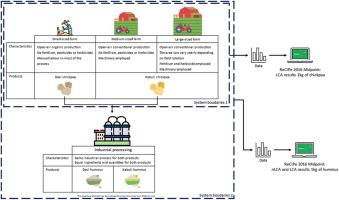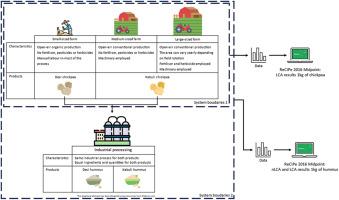Kabuli和Desi鹰嘴豆(Cicer arietinum L.)在农场和产品水平上的环境和营养可持续性比较分析
IF 10
1区 环境科学与生态学
Q1 ENGINEERING, ENVIRONMENTAL
引用次数: 0
摘要
采用生命周期评价(LCA)方法,对欧洲地区在有机和常规耕作制度下种植黑鹰嘴豆(德西型)和白鹰嘴豆(卡布里型)的环境影响进行了评价。以质量为基础(1公斤产品)的LCA表明,由于在常规系统中该品种的产量较高和更成熟的耕作方式,喀布尔鹰嘴豆的种植具有较低的全球变暖潜势、用水量和土地占用。本研究还考察了由这两种原料制成的鹰嘴豆泥对环境的影响。以质量为基础(1公斤产品)的LCA表明,使用Kabuli鹰嘴豆生产鹰嘴豆泥通常对环境的影响较低,这主要是因为Kabuli鹰嘴豆的产量效率更高,并且优化了耕作方法。然而,当考虑营养LCA时,使用营养密度作为功能单位(NDU), Desi鹰嘴豆泥在大多数类别中表现出较低的环境影响,特别是在富营养化和酸化潜力方面。该研究在比较有机农业和传统农业系统的同时,强调了环境影响和营养效益之间的权衡,表明将德西鹰嘴豆等未充分利用的类型纳入其中可能有助于建立一个更可持续、营养更多样化的粮食系统。本文章由计算机程序翻译,如有差异,请以英文原文为准。


Comparative environmental and nutritional sustainability analysis of Kabuli and Desi Chickpea (Cicer arietinum L.) types at the farm and product level
Life Cycle Assessment (LCA) was conducted to evaluate the environmental impact of cultivating black (Desi type) and white (Kabuli type) chickpeas in Europe under both organic and conventional farming systems. The LCA on a mass basis (1 kg of product) showed that Kabuli chickpea cultivation had a lower global warming potential, water use, and land occupation due to higher yields and more established farming practices for this variety in conventional systems. This study also examined the environmental impact of producing hummus derived from these two raw materials. The LCA on a mass basis (1 kg of product) showed that hummus production generally had a lower environmental impact when using Kabuli chickpeas primarily due to higher yield efficiency and optimised farming practices for the Kabuli type. However, when nutritional LCA is considered, using Nutrient Density as a functional unit (NDU), Desi hummus demonstrates lower environmental impacts in most categories, particularly regarding eutrophication and acidification potential. The study highlights the trade-offs between environmental impacts and nutritional benefits while comparing organic and conventional farming systems, suggesting that incorporating underutilised types such as Desi chickpeas could contribute to a more sustainable and nutritionally diverse food system.
求助全文
通过发布文献求助,成功后即可免费获取论文全文。
去求助
来源期刊

Journal of Cleaner Production
环境科学-工程:环境
CiteScore
20.40
自引率
9.00%
发文量
4720
审稿时长
111 days
期刊介绍:
The Journal of Cleaner Production is an international, transdisciplinary journal that addresses and discusses theoretical and practical Cleaner Production, Environmental, and Sustainability issues. It aims to help societies become more sustainable by focusing on the concept of 'Cleaner Production', which aims at preventing waste production and increasing efficiencies in energy, water, resources, and human capital use. The journal serves as a platform for corporations, governments, education institutions, regions, and societies to engage in discussions and research related to Cleaner Production, environmental, and sustainability practices.
 求助内容:
求助内容: 应助结果提醒方式:
应助结果提醒方式:


